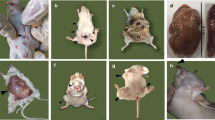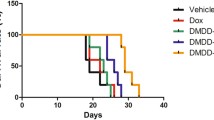Abstract
Isoxazole derivatives are an important group of chemotherapeutic prototypes. In the current study, we have synthesized few isoxazole derivatives and tested them for their antiproliferative properties in cancer cell lines such as MCF7 and HeLa. The lead compound, 3-(3,4-dimethoxyphenyl)-5-(thiophen-2-yl)isoxazole (2b), showed considerable inhibition of proliferation of MCF7 and HeLa cells with the IC50 values of 19.5 and 39.2 µM, respectively. Cell cycle analyses and annexin-FITC staining in 2b-treated breast adenocarcinoma cells (MCF7) showed increased sub-G1 population and apoptosis. Furthermore, we tested the tumor inhibitory effect of 2b and estrogen receptor expression profile in DMBA-induced mammary tumors in Sprague–Dawley rats. The gross morphology of tumor studies was investigated by histopathology and ERα protein expression was evaluated by immunohistochemistry, which showed tumor regression and downregulation of ERα in tumor cells. The present results implicate that compound 2b could be used for the further derivatization for the treatment of breast cancer.







Similar content being viewed by others
References
Manson JE, Martin KA (2001) Clinical practice. Postmenopausal hormone-replacement therapy. N Engl J Med 345:34–40
Green S, Walter P, Kumar V, Krust A, Bornert JM, Argos P, Chambon P (1986) Human oestrogen receptor cDNA: sequence, expression and homology to v-erb-A. Nature 320:134–139
Kuiper GG, Enmark E, Pelto-Huikko M, Nilsson S, Gustafsson JA (1996) Cloning of a novel receptor expressed in rat prostate and ovary. Proc Natl Acad Sci USA 93:5925–5930
Dahlman-Wright K, Cavailles V, Fuqua SA, Jordan VC, Katzenellenbogen JA, Korach KS, Maggi A, Muramatsu M, Parker MG, Gustafsson JA (2006) International union of pharmacology. LXIV. Estrogen receptors. Pharmacol Rev 58:773–781
Moon BS, Carlson KE, Katzenellenbogen JA, Choi TH, Chi DY, Kim JY, Cheon GJ, Koh HY, Lee KC, An G (2009) Synthesis and evaluation of aryl-substituted diarylpropionitriles, selective ligands for estrogen receptor beta, as positron-emission tomographic imaging agents. Bioorg Med Chem 17:3479–3488
Barrett I, Meegan MJ, Hughes RB, Carr M, Knox AJ, Artemenko N, Golfis G, Zisterer DM, Lloyd DG (2008) Synthesis, biological evaluation, structural-activity relationship, and docking study for a series of benzoxepin-derived estrogen receptor modulators. Bioorg Med Chem 16:9554–9573
Yermolina MV, Wang J, Caffrey M, Rong LL, Wardrop DJ (2011) Discovery, synthesis, and biological evaluation of a novel group of selective inhibitors of filoviral entry. J Med Chem 54:765–781
Vorobyeva DV, Karimova NM, Odinets IL, Roschenthaler GV, Osipov SN (2011) Click-chemistry approach to isoxazole-containing alpha-CF3-substituted alpha-aminocarboxylates and alpha-aminophosphonates. Org Biomol Chem 9:7335–7342
Volkova YA, Averina EB, Grishin YK, Bruheim P, Kuznetsova TS, Zefirov NS (2010) Unexpected heterocyclization of electrophilic alkenes by tetranitromethane in the presence of triethylamine. Synthesis of 3-nitroisoxazoles. J Org Chem 75:3047–3052
Filippakopoulos P, Knapp S (2014) Targeting bromodomains: epigenetic readers of lysine acetylation. Nat Rev Drug Discov 13:337–356
Sharath Kumar KS, Hanumappa A, Vetrivel M, Hegde M, Girish YR, Byregowda TR, Rao S, Raghavan SC, Rangappa KS (2015) Antiproliferative and tumor inhibitory studies of 2,3 disubstituted 4-thiazolidinone derivatives. Bioorg Med Chem Lett 25:3616–3620
Poutiainen PK, Venalainen TA, Perakyla M, Matilainen JM, Vaisanen S, Honkakoski P, Laatikainen R, Pulkkinen JT (2010) Synthesis and biological evaluation of phenolic 4,5-dihydroisoxazoles and 3-hydroxy ketones as estrogen receptor alpha and beta agonists. Bioorg Med Chem 18:3437–3447
Sharath Kumar KS, Hanumappa A, Hegde M, Narasimhamurthy KH, Raghavan SC, Rangappa KS (2014) Synthesis and antiproliferative effect of novel 4-thiazolidinone-, pyridine- and piperazine-based conjugates on human leukemic cells. Eur J Med Chem 81:341–349
Hegde M, Sharath Kumar KS, Thomas E, Ananda H, Raghavan SC, Rangappa KS (2015) A novel benzimidazole derivative binds to the DNA minor groove and induces apoptosis in leukemic cells. RSC Adv 5:93194–93208
Kavitha CV, Nambiar M, Ananda Kumar CS, Choudhary B, Muniyappa K, Rangappa KS, Raghavan SC (2009) Novel derivatives of spirohydantoin induce growth inhibition followed by apoptosis in leukemia cells. Biochem Pharmacol 77:348–363
LG L (1968) 3rd edn. McGrawHill, New York
Poola I, Yue Q (2007) Estrogen receptor alpha (ER alpha) mRNA copy numbers in immunohistochemically ER alpha-positive-, and negative breast cancer tissues. BMC Cancer 7:56
Hsu KC, Chen YF, Lin SR, Yang JM (2011) iGEMDOCK: a graphical environment of enhancing GEMDOCK using pharmacological interactions and post-screening analysis. BMC Bioinform 12(Suppl 1):S33
Yang JM, Shen TW (2005) A pharmacophore-based evolutionary approach for screening selective estrogen receptor modulators. Proteins 59:205–220
Tikoo K, Kumar P, Gupta J (2009) Rosiglitazone synergizes anticancer activity of cisplatin and reduces its nephrotoxicity in 7, 12-dimethyl benz{a}anthracene (DMBA) induced breast cancer rats. BMC Cancer 9:107
Girish YR, Sharath Kumar KS, Manasa HS, Shashikanth S (2014) ZnO: an ecofriendly green nano catalyst for the synthesis of pyrazole derivatives under aqueous media. J Chin Chem Soc 61:1175–1179
Narasimhamurthy KH, Chandrappa S (2013) Sharath Kumar KS, Swaroop TR RK and Synthetic utility of propylphosphonic anhydride–DMSO media: an efficient one-pot three component synthesis of 2-arylquinolines. Chem Lett 42:1073–1075
Narasimhamurthy KH, Chandrappa S, Sharath Kumar KS, Harsha KB, Ananda H, Rangappa KS (2014) Easy access for the synthesis of 2-aryl 2,3-dihydroquinazolin-4(1H)-ones using gem-dibromomethylarenes as synthetic aldehyde equivalent. RSC Adv 4:34479–34486
Hegde M, Mantelingu K, Swarup HA, Pavankumar CS, Qamar I, Raghavan SC, Rangappa KS (2016) Novel PARP inhibitors sensitize human leukemic cells in an endogenous PARP activity dependent manner. RSC Adv 6:6308–6319
Raghava B, Parameshwarappa G, Acharya A, Swaroop TR, Rangappa KS, Illa H (2014) Cyclocondensation of hydroxylamine with 1,3-bis(het)arylmonothio 1,3-diketones and 1,3-bis(het)aryl-3-(methylthio)-2-propenones: synthesis of 3,5-bis(het)arylisoxazoles with complementary regioselectivity. Eur J Org Chem 9:1882–1892
Baburajeev CP, Dhananjaya Mohan C, Ananda H, Rangappa S, Fuchs JE, Jagadish S, Sivaraman Siveen K, Chinnathambi A, Ali Alharbi S, Zayed ME, Zhang J, Li F, Sethi G, Girish KS, Bender A, Basappa Rangappa KS (2015) Development of novel triazolo-thiadiazoles from heterogeneous “green” catalysis as protein tyrosine phosphatase 1B inhibitors. Sci Rep 5:14195
Hewings DS, Fedorov O, Filippakopoulos P, Martin S, Picaud S, Tumber A, Wells C, Olcina MM, Freeman K, Gill A, Ritchie AJ, Sheppard DW, Russell AJ, Hammond EM, Knapp S, Brennan PE, Conway SJ (2013) Optimization of 3,5-dimethylisoxazole derivatives as potent bromodomain ligands. J Med Chem 56:3217–3227
Hewings DS, Wang M, Philpott M, Fedorov O, Uttarkar S, Filippakopoulos P, Picaud S, Vuppusetty C, Marsden B, Knapp S, Conway SJ, Heightman TD (2011) 3,5-dimethylisoxazoles act as acetyl-lysine-mimetic bromodomain ligands. J Med Chem 54:6761–6770
Li X, Huang J, Yi P, Bambara RA, Hilf R, Muyan M (2004) Single-chain estrogen receptors (ERs) reveal that the ERalpha/beta heterodimer emulates functions of the ERalpha dimer in genomic estrogen signaling pathways. Mol Cell Biol 24:7681–7694
Sdelci S, Lardeau CH, Tallant C, Klepsch F, Klaiber B, Bennett J, Rathert P, Schuster M, Penz T, Fedorov O, Superti-Furga G, Bock C, Zuber J, Huber KV, Knapp S, Muller S, Kubicek S (2016) Mapping the chemical chromatin reactivation landscape identifies BRD4-TAF1 cross-talk. Nat Chem Biol 12:504–510
Shen DW, Pouliot LM, Hall MD, Gottesman MM (2012) Cisplatin resistance: a cellular self-defense mechanism resulting from multiple epigenetic and genetic changes. Pharmacol Rev 64:706–721
Montenegro RC, Clark PG, Howarth A, Wan X, Ceroni A, Siejka P, Nunez-Alonso GA, Monteiro O, Rogers C, Gamble V, Burbano R, Brennan PE, Tallant C, Ebner D, Fedorov O, O’Neill E, Knapp S, Dixon D, Muller S (2016) BET inhibition as a new strategy for the treatment of gastric cancer. Oncotarget. doi:10.18632/oncotarget.9766
Poma P, Notarbartolo M, Labbozzetta M, Maurici A, Carina V, Alaimo A, Rizzi M, Simoni D, D’Alessandro N (2007) The antitumor activities of curcumin and of its isoxazole analogue are not affected by multiple gene expression changes in an MDR model of the MCF-7 breast cancer cell line: analysis of the possible molecular basis. Int J Mol Med 20:329–335
Mohibi S, Mirza S, Band H, Band V (2011) Mouse models of estrogen receptor-positive breast cancer. J Carcinog 10:35
Chatterjee S, Malhotra R, Varghese F, Bukhari AB, Patil A, Budrukkar A, Parmar V, Gupta S, De A (2013) Quantitative immunohistochemical analysis reveals association between sodium iodide symporter and estrogen receptor expression in breast cancer. PLoS One 8:e54055
Rochefort H, Borgna JL, Evans E (1983) Cellular and molecular mechanism of action of antiestrogens. J Steroid Biochem 19:69–74
Warri AM, Huovinen RL, Laine AM, Martikainen PM, Harkonen PL (1993) Apoptosis in toremifene-induced growth inhibition of human breast cancer cells in vivo and in vitro. J Natl Cancer Inst 85:1412–1418
Somai S, Chaouat M, Jacob D, Perrot JY, Rostene W, Forgez P, Gompel A (2003) Antiestrogens are pro-apoptotic in normal human breast epithelial cells. Int J Cancer 105:607–612
Thiantanawat A, Long BJ, Brodie AM (2003) Signaling pathways of apoptosis activated by aromatase inhibitors and antiestrogens. Cancer Res 63:8037–8050
Acknowledgments
H. A. thanks ICMR for SRF No. 45/54/2013-PHA/BMS, Dated: 08.12.2014 for research fellowship. We also thank Dr. Suguna Rao, Dr. Nishana M, Dr. Robin Sebastian, and other members of Sahees C. Raghavan group, Department of Biochemistry, Indian Institute of Science, Bangalore for suggestions and critical reading of the manuscript.
Author information
Authors and Affiliations
Corresponding author
Additional information
H. Ananda and K. S. S. Kumar have contributed equally to this work.
Rights and permissions
About this article
Cite this article
Ananda, H., Kumar, K.S.S., Hegde, M. et al. Induction of apoptosis and downregulation of ERα in DMBA-induced mammary gland tumors in Sprague–Dawley rats by synthetic 3,5-disubstituted isoxazole derivatives. Mol Cell Biochem 420, 141–150 (2016). https://doi.org/10.1007/s11010-016-2777-z
Received:
Accepted:
Published:
Issue Date:
DOI: https://doi.org/10.1007/s11010-016-2777-z




